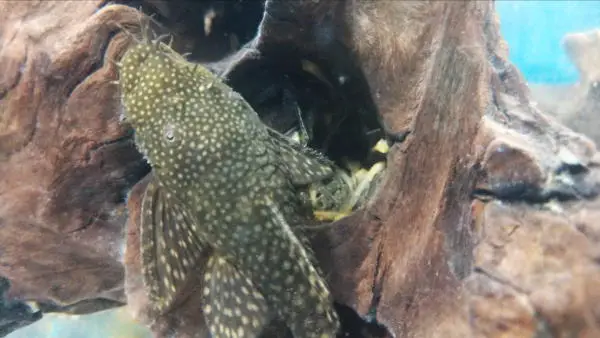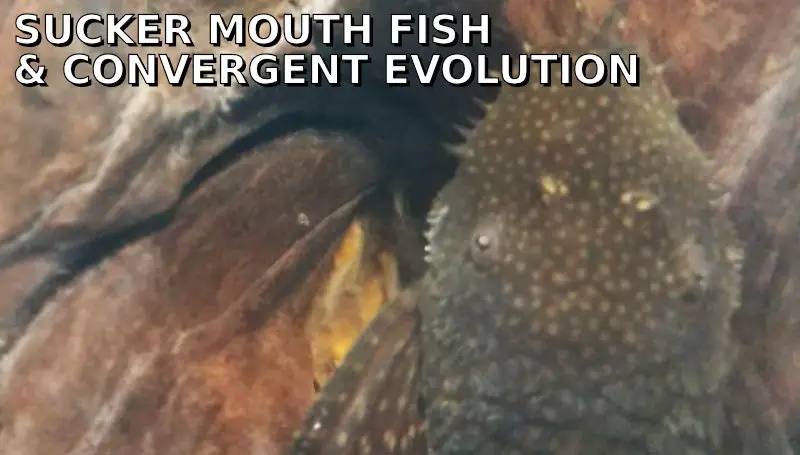Ever wondered if plecos, Chinese algae eaters, and panda garras are related? It’s a fair question, because they all have sucker mouths! So, maybe they are related? Nope, they’re not related even though they have similar traits.
This is called convergent evolution!
Convergent evolution, simply put, is when different animals evolve in a similar way independently. The classic example your high school biology teacher will probably use is bats and birds. They both turned their forearms into wings, but did so independently. Another good example is the body shape of a dolphin and why it is somewhat reminiscent of that of a shark—convergent evolution, it’s really cool!
So Sucker Mouth Fish!
The first sucker mouth fish I saw as a kid was, you guessed it, the common pleco*. And it blew my mind! What a cool and unusual animal—I watched as it attached itself to the glass and scraped away by moving its lips up and down.
And it wasn’t long before I saw a fish with many common names—the common algae eater, aka the Chinese algae eater, or just algae eater, and sometimes sucker loach! Of course, I’m talking about Gyrinocheilus aymonieri.
Even as a young teenager, I noticed instantly that, while the different species of plecos and Gyrinocheilus aymonieri both had sucker mouths, they seemed fundamentally different in many other ways.
Are plecos and Chinese algae eaters related? Yes, of course they are, because they’re both fish and they share a common ancestor. The better question is, are they closely related? Not really, no. And most importantly, did they both inherit the sucker mouth from a common ancestor or did they evolve it separately? They evolved it separately!
So, next time you hear somebody talking about how birds and bats are the quintessential example of convergent evolution, spare a thought for the sucker mouthed fish in the aquarium hobby!
What Should I Feed My Plecos & Algae Eaters?
I like to feed veggies—stuff like green beans, zucchini (courgette), and broccoli. But, when I don’t have any in I go directly to Hikari’s sinking algae wafers (affiliate link).
My bristlenose plecos love them.
Pleco Vs. Chinese Algae Eater
If you want a sucker mouthed fish for your aquarium, but you’re not sure which one to go for. Well, it really depends on your setup and which fish you prefer the aesthetic of.
However, for the average hobbyist, plecos (depending on the species) make for better aquarium inhabitants than Chinese algae eaters. The algae eater can grow quite large, and often becomes increasingly aggressive as it matures. Furthermore, it doesn’t actually eat a lot of algae.

As such, I’d point you in the direction of a pleco. Although, you should avoid the common pleco (and other large species) as they can eventually outgrow the typical home aquarium. However, lots of pleco species do stay small for their entire lives.
So Which Pleco Species Should I Get?
While convergent evolution has given them both sucker mouths, these fish are definitely not similar.
The bristlenose pleco is my top recommendation! It’s commonly available for a fair price, and when young it does a great job of eating algae.
However, it will need more than just algae in its diet. It’ll definitely need some driftwood (also known as bog wood in other parts of the world). Grab it on Amazon.com (affiliate link).This is because it scrapes and consumes the wood, which in turn aids in digestion. In addition to that, again, I recommend veggies and algae wafers.
Also, plecos are often referred to in the aquarium hobby as “poop machines”. So, you’ll need a good gravel vacuum and siphon to get all of that poop out quite regularly.
More Recommended Products
- Best Food For Your Fish
- Fluval Plant 3.0 Vs. Finnex Planted +
- Gift Ideas For Aquarium Lovers
- Finnex Stingray vs Stingray 2
Further Reading
Notes
*The name “common pleco” is troublesome. This is because it is applied to a number of different species incorrectly. Sources quite often state that the common pleco’s scientific name is “Hypostomus Plecostomus” which isn’t necessarily correct. In the aquarium hobby, the fish typically sold as a common pleco is actually “Pterygoplichthys pardalis”. For more info, check out PlanetCatfish.com. It is, hands down, the best source for pleco facts.





